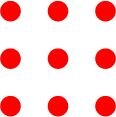
Lição 11: Pensamento Lateral
Desde tenra idade, somos ensinados a aceitar certas convenções sociais e ver o mundo de determinada maneira. Esses atalhos ajudam-nos a comunicar eficazmente e tomar decisões eficientes. Mas também podem restringir nossos pontos de vista, atenuar a nossa criatividade e levar-nos a falsas conclusões.
Os enigmas sobre pensamento lateral exploram essas situações, obrigando-nos a remover nossos pensamento predefinidos e "pensar fora da caixa.".
Puzzles de pensamento lateral são dos mais difíceis de resolver porque eles nos obrigam a utilizar métodos originais e criativos. Enquanto isso os torna difícil e irritante, também torna desafiador e gratificante.
Exemplos
Puzzle de 9 Pontos

O exemplo clássico do pensamento lateral é o puzzle de nove pontos. Imprima a imagem, em seguida, traça quatro (ou menos) linhas rectas que passam por todos os nove pontos sem levantar o lápis do papel ou refazer qualquer linha.
A razão por termos dificuldades para resolver este tipo de quebra-cabeça é que nós impomos limites a nós mesmos. A maioria das pessoas vai manter as linhas dentro das bordas, mas o quebra-cabeça não impõe tal restrição.
Mesmo quando tu pensas fora da caixa, estás realmente pensando dentro de uma caixa maior. Se desafiares teus preconceitos, então serás capaz de completar o quebra-cabeça com apenas três linhas. Continua expandindo a tua caixa metafórica. Envolvendo o papel em volta do cilindro de tamanho certo no ângulo correto permite que conectes todos os pontos com apenas uma linha.

Situação
Um dos tipos mais comuns de exercícios de pensamento lateral é o de situação. Estes puzzles dão uma pequena quantidade de informações e pede para explicar a situação. Por exemplo:
1. Num cesto tem seis ovos. Seis pessoas tiram cada uma um ovo. Como é que é possível restar ainda um ovo no cesto? Para ver a resposta, põe o cursor do rato  .
.

Lesson 11: Lateral Thinking
From an early age, we’re taught to accept certain social conventions and see the world in particular ways. These shortcuts assist us in communicating effectively and making efficient decisions. But they also can restrict our views, dampen our creativity, and lead us to false conclusions.
Occasionally, we’re stymied when certain situations don’t match our preconceptions. Lateral thinking puzzles exploit these situations, forcing us to remove our blinders and “think outside the box.”.
Lateral thinking problems are some of the hardest to solve because they require us to use original and creative methods. While this makes them difficult and infuriating, it also makes them challenging and rewarding.
Examples
Nine Dots Puzzle

The classic lateral thinking example is the Nine Dots puzzle. Print the above image on a piece of paper, then draw four (or fewer) straight lines that pass through all nine dots without lifting your pencil from the paper or retracing any line.
The reason you might have trouble solving this puzzle is that we impose boundaries upon ourselves. (Were you taught to colour inside the lines?) Most people keep their lines within the edges of the square, but the puzzle imposes no such restriction. Try again.
Even when you “think outside the box,” you’re really just thinking inside a bigger box. If you challenge your assumptions further, then you can complete the puzzle with only three lines. Continue expanding your metaphorical box. Wrapping the paper around the right-sized cylinder at the correct angle allows you to connect all the dots with a single line. Using a giant pencil with a dull point also accomplishes the task with a single line.

Situation Puzzles
One of the most common types of lateral thinking exercises is the situation puzzle. These puzzles give you a small amount of information and ask you to explain the situation. For instance:
1. There are six eggs in a basket. Six people each take one egg. How is it possible that one egg remains in the basket? To see the answer, position your cursor  .
.
Puzzle L11: Cache Mobile
Qual o número (K) do lugar que ocupa o teu cache mobile?
What is the number (K) of the place that occupies your carr

Coordenadas finais | Final coordinates
N 32º 45. (K*22) W 017º 05.668

